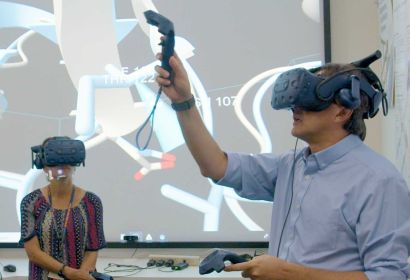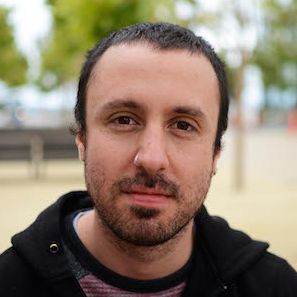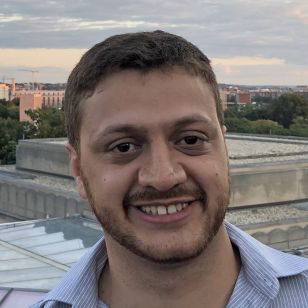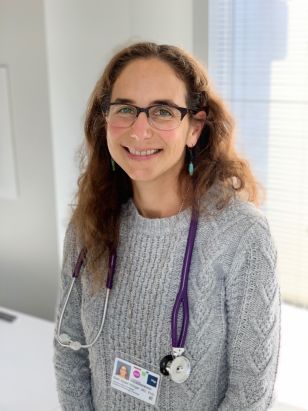- About
- Organization
- Organization Overview
- Dean’s Office
- Department of Bioengineering and Therapeutic Sciences
- Department of Clinical Pharmacy
- Department of Pharmaceutical Chemistry
- Quantitative Biosciences Institute
- Org Chart
- Research
- Education
- Patient Care
- People
- News
- Events
VR drug discovery makes precision therapy a reality
UCSF ChimeraX software enables scientists to “walk” through molecules
By Levi Gadye / Wed Oct 16, 2019

Beth Apsel Winger, MD, PhD (left), and Matthew Jacobson, PhD (right) explore a cancer-causing mutation in a protein in virtual reality, using UCSF ChimeraX.
UC San Francisco pediatric oncologist Beth Apsel Winger, MD, PhD, was stumped. A colleague was struggling to successfully treat a young cancer patient. The child’s malignant tumor was tested for genetic anomalies to break the impasse. The test revealed a surprising mutation in an important protein, known as a kinase, that can spur unchecked tumor growth.
Winger and her colleagues hadn’t encountered this mutation before, and standard drug therapies had failed to help their patient. What was preventing these drugs from working? And what, if anything, might actually stop this child’s tumor in its tracks?
Winger called Matthew Jacobson, PhD, chair of the UCSF School of Pharmacy Department of Pharmaceutical Chemistry, for help getting to the root of this molecular mystery.
Jacobson’s lab uses computer simulations to solve molecular puzzles like these. And thanks to the lab’s adoption of a tool from a research group led by molecular visualization pioneer and faculty member Thomas Ferrin, PhD, also in the Department of Pharmaceutical Chemistry, scientists and clinicians, like Winger, can now make sense of cancer-causing mutations by virtually walking through a protein and exploring its structure.
A walk through a molecule
Jacobson tasked two of his postdoctoral scientists, Wilian Cortopassi, PhD, and Diego Garrido Ruiz, PhD, with helping Winger understand the young patient’s rare form of cancer.
Cortopassi had been beta testing a new piece of software from the Ferrin Lab, called ChimeraX, that allowed him to view the structures of proteins in virtual reality (VR). Garrido Ruiz had expertise with the protein of interest. The research pair simulated models of the mutated protein and the normal version of the protein, hoping that the differences between the two might reveal a more effective way to beat back the child’s cancer.

Diego Garrido Ruiz, PhD

Wilian Cortopassi, PhD
They forwarded their preliminary results to Winger.
Hunched over a flat-screen computer monitor, Winger pored over simulated images of the mutated, cancer-causing protein, but something wasn’t clicking.
On her monitor, the two versions of the protein looked very similar. So Cortopassi and Garrido Ruiz invited Winger to cross the street at UCSF’s Mission Bay campus—from UCSF Benioff Children’s Hospital San Francisco to Genentech Hall—and take a “walk” through the two versions of the molecules in 3D, using VR.
Cortopassi handed Winger a pound-and-a-half headset. She put it on, totally covering her eyes. Next, he led her into the center of the room, assuring her that she could walk a few feet in any direction and not bump into any chairs or walls.
Cortopassi then fired up ChimeraX. Winger was now looking at the site of the mutation on the protein, her perspective shrunk down to the atomic level where she could observe each 3D nook and cranny of the protein.
She craned her neck, tilted her head, and walked around in virtual space to get a better view.
Suddenly, the change in the mutated protein’s shape jumped out at her.
“An hour before, Beth couldn’t see a difference. But with VR, looking at the same data, she quickly spotted it,” recalled Cortopassi.
This Eureka! moment validated what Ferrin and Jacobson have hoped all along: VR could spark discovery, even for clinicians like Winger, and would soon produce results that clinicians could use to effectively treat cancer—and, eventually, other diseases.
A legacy of molecular visualization at UCSF
It’s no coincidence that Ferrin’s VR visualization technology was developed at UCSF. In 2018, Irwin ‘Tack’ Kuntz, PhD; Robert Langridge, PhD; and the late Peter Kollman, PhD, were awarded the UCSF Medal for laying the groundwork for modern molecular visualization.
In the early 2000s, Ferrin’s group took molecular visualization to the next level with Chimera, a software program that soon became one of a handful of standard packages for scientists like those in the Jacobson Lab. Chimera was powerful, but it flattened 3D structures onto a 2D screen, making it difficult to view subtle, but important, aspects of a molecule’s shape.
Within a decade, Ferrin realized that a new VR consumer technology could forever change the field.
“The driving factor in all this was the advent of low-cost, commercially available virtual reality headsets—I’d say, starting with the Oculus Rift,” Ferrin said.
In 2015, he and his colleagues adapted Chimera for VR and dubbed their new software ChimeraX.
For Jacobson, the technology is the culmination of decades of attempts to understand how proteins—the workhorses of the cell—behave during health and disease. “Everything we do [in my lab] really has to do with the three-dimensional structure of proteins,” he said.
Jacobson recalls straining to cross his eyes to make printed images of molecules jump off the page, hoping to identify places where new drugs might stick. Few fellow scientists learned the technique themselves, he said.
Cortopassi ended up putting on a VR headset and giving Ferrin’s ChimeraX a try. It took months for him to learn the ropes. He soon became an evangelist for the technology, but his colleagues, like Garrido Ruiz, were a bit slower to warm up to it.
“I thought it was gimmicky at first,” said Garrido Ruiz, “and then I started using it.” ChimeraX began producing results faster than the Jacobson Lab had expected—and revolutionizing the lab’s workflow.
To the VR room!
Meetings in the Jacobson Lab are different now. Instead of preparing lengthy PowerPoint presentations destined to be projected onto a 2D screen, scientists like Garrido Ruiz and Cortopassi prepare their data to be shown in 3D in VR. Then they lead their colleagues on a virtual tour of their work, strolling through molecules they’re studying, with one or two scientists wearing VR headsets while the rest observe a projection of the 3D image on the wall. (Logistically, it’s too challenging to have more than two people using the headsets in the small VR room).
If something doesn’t make sense, a VR headset can be handed off, giving a bystander an immediate, insider’s look at a portion of a molecule. With two scientists moving around in the same virtual space, sharing an insight is now as simple as pointing to a particular kink in a protein and guiding colleagues to see it for themselves.
“In terms of the efficiency of visualization, it probably speeds things up by a factor of at least two or three,” said Jacobson.
The technology has also made it easier for the Jacobson Lab to communicate its work to a wider range of scientists, according to Cortopassi.
“Even if our collaborators aren’t used to looking at molecular structures, VR helps us convey more clearly what we do and what we can bring to the table for their projects,” he said.
Back to the clinic
This first collaboration between the Jacobson Lab and Winger, about pediatric cancer, proved to be a turning point. Winger had first worked with Jacobson during her time as a postdoctoral scientist in the lab of Neil Shah, MD, PhD, a UCSF adult oncologist and kinase expert.
By drawing Winger into the structural biology side of her own project, Cortopassi and Garrido Ruiz themselves gained a closer connection to the clinical implications of their work—allowing ideas from VR to be rapidly vetted in the lab, with little downtime.

Beth Winger, MD, PhD
“With Winger, it has been extremely rewarding, because we propose experiments directly from the VR room,” said Cortopassi. “She takes our suggestions to her laboratory bench, performs the experiments, and validates what we’re seeing in VR.”
These discussions are also accelerating Winger’s clinical work by more rapidly translating the insights of Cortopassi, Garrido Ruiz, and Jacobson into better therapies for patients.
“This research is for patients who have failed standard therapy,” she said. “You can’t wait six months in the lab for these patients.”
The collaboration among Winger and the Jacobson and Shah labs recently culminated with a paper in Cancer Research detailing how patients with a certain type of cancer-causing mutation in a gene called KIT could benefit from a unique combination of two already-available drugs. Because both this mutation and clinical trials involving children are rare, the paper adds some of the missing information needed to determine the best treatment paths for these cases.
Visualization also gave Winger and her clinical colleagues the confidence to start their pediatric leukemia patient on a new, targeted therapy—one that may finally prove effective after the failure of multiple rounds of standard therapies.
Winger is continuing to collaborate with Jacobson and his colleagues, using VR to understand other rare, cancer-causing mutations that routinely thwart the best available therapies.
Bringing UCSF science and medicine to the public
VR doesn’t just resonate with scientists and practitioners. During a recent event for non-scientists at Mission Bay, a line formed outside the VR room.
To add a bit of fun to the event, Cortopassi and Garrido Ruiz had set up a “challenge” for attendees: to find a small molecule (known as a ligand) labeled in pink, deep in the recesses of a complicated protein.
Most people quickly got “lost inside the protein,” according to Cortopassi. But one attendee didn’t seem to have much trouble crawling through the molecular maze in VR.
“Oh look, the ligand is here!” someone shouted. The someone turned out to be a 10-year-old boy.
“The beauty of this technology isn’t just that we can be smarter about our work—we can finally share our work with anyone,” said Cortopassi.

Postdoctoral scientist Wilian Cortopassi, PhD, manipulates a protein structure in virtual reality.
Tags
Category:
Sites:
School of Pharmacy, Department of Pharmaceutical Chemistry, PharmD Degree Program
About the School: The UCSF School of Pharmacy aims to solve the most pressing health care problems and strives to ensure that each patient receives the safest, most effective treatments. Our discoveries seed the development of novel therapies, and our researchers consistently lead the nation in NIH funding. The School’s doctor of pharmacy (PharmD) degree program, with its unique emphasis on scientific thinking, prepares students to be critical thinkers and leaders in their field.






